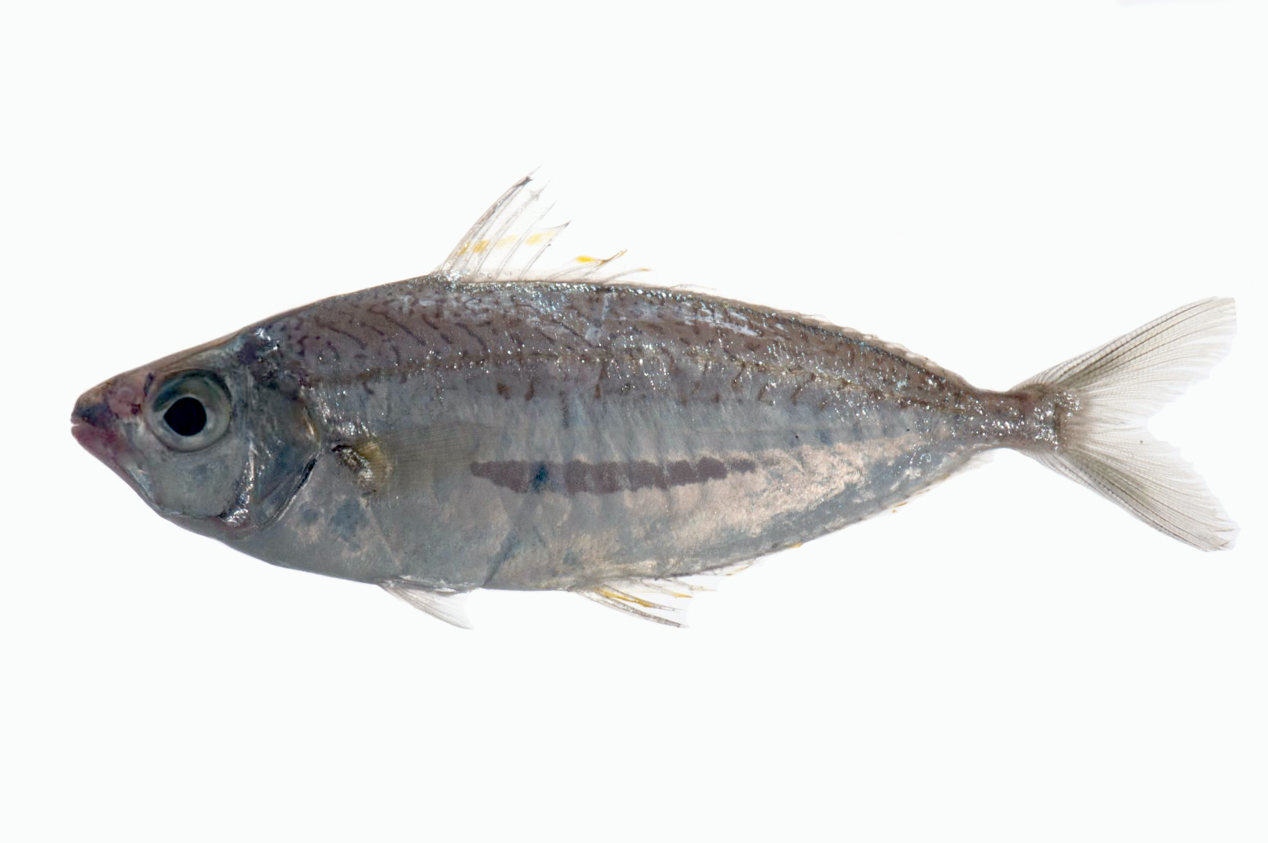- Classification
- ACTINOPTERYGII
- PERCIFORMES
- LEIOGNATHIDAE
- Photolateralis
- stercorarius
Oblong Slipmouth, Photolateralis stercorarius (Evermann & Seale 1907)
Other Names: Slender Ponyfish, Slipmouth

An Oblong Slipmouth, Photolateralis stercorarius, USNM 431576, from south of Puerto Princesa City, Palawan, Philippines, April 2014. Source: Jeffrey T. Williams / Division of Fishes, United States National Museum, Smithsonian Institution. License: CC by Attribution-NonCommercial-ShareAlike
Summary:
An elongate ponyfish with irregular green and dark marbling on the back, a silvery-white lower side, a black blotch on the snout, a yellow margin and a yellow stripe on the spinous dorsal fin and anal fin. Males have a bluish stripe along the sides just below the midline.
Cite this page as:
Bray, D.J. 2022, Photolateralis stercorarius in Fishes of Australia, accessed 27 Apr 2024, https://fishesofaustralia.net.au/Home/species/5107
Oblong Slipmouth, Photolateralis stercorarius (Evermann & Seale 1907)
More Info
|
Distribution |
Torres Strait, Queensland. Elsewhere the species occurs in the tropical east-Indo-west Pacific. Forms schools over soft bottom habitats, including inner reef flats, silty coastal waters and mangroves. |
|
Features |
Dorsal fin VIII, 16; Anal fin III, 14; Pectoral fin 16-18; Lateral-line scales 58-61; Gill rakers 5-6 + 11-14 = 16-20. Body elongate, moderately compressed, dorsal and ventral profiles smoothly convex, slender but deeper than head length; depth 2.8–3.6 in SL. Mouth protruding downwards, profile of lower jaw almost straight; teeth small, slender, in a single row on jaws. Scales deciduous, cheek, breast, and belly completely scaled. Dorsal and anal-fin spines not elongated. |
|
Colour |
Body brownish dorsally, silvery-white ventrally; black blotch on snout; dark irregular oblique lines indistinctly on dorsolateral body surface; dorsal and anal fins with yellow stripes. |
|
Similar Species |
In Australia, this species has been known as Equulites stercorarius and Leiognathus stercorarius. |
|
Etymology |
The specific name is from the Latin stercorarius (= of, or pertaining to dung), in reference to "the fly-specks on the side." |
|
Species Citation |
Leiognathus stercorarius Evermann & Seale 1907, Bulletin of the Bureau of Fisheries (U.S.) for 1906 26: 67, fig. 6. Type locality: Bulan, Sorsogon, Philippines. |
|
Author |
Bray, D.J. 2022 |
|
Resources |
Oblong Slipmouth, Photolateralis stercorarius (Evermann & Seale 1907)
References
Evermann, B.W. & Seale, A. 1907. Fishes of the Philippine Islands. Bulletin of the Bureau of Fisheries (U.S.) for 1906 26: 49-110 figs 1-22 See ref at BHL
Kimura, S., Motomura, H. & Iwatsuki, Y. 2008. Equulites Fowler 1904, a senior synonym of Photoplagios Sparks, Dunlap, and Smith 2005 (Perciformes: Leiognathidae). Ichthyological Research 55: 204-205 https://doi.org/10.1007/s10228-008-0041-6 (as Equulites stercorarius)
Randall, J.E. 2005. Reef and shore fishes of the South Pacific. New Caledonia to Tahiti and the Pitcairn Islands. Honolulu : University of Hawaii Press 707 pp. (as Leiognathus stercorarius)
Sparks, J.S. & Chakrabarty, P. 2015. Description of a new genus of ponyfishes (Teleostei: Leiognathidae), with a review of the current generic-level composition of the family. Zootaxa 3947(2): 181–190 http://dx.doi.org/10.11646/zootaxa.3947.2.2
Sparks, J.S., Dunlap, P.V. & Smith, W.L. 2005. Evolution and diversification of a sexually dimorphic luminescent system in ponyfishes (Teleostei: Leiognathidae), including diagnoses of two new genera. Cladistics 21: 305-327 https://doi.org/10.1111/j.1096-0031.2005.00067.x (as Photoplagios stercorarius)
Suzuki, T. & Kimura, S. 2017. Taxonomic revision of the Equulites elongatus (Günther 1874) species group (Perciformes: Leiognathidae) with the description of a new species. Ichthyological Research 64(3): 339-352, https://doi.org/10.1007/s10228-017-0572-9
Woodland, D.J., Premcharoen, S. & Cabanban, A.S. 2001. Leiognathidae. pp. 2792-2823 in Carpenter, K.E. & Niem, V.H. (eds). The Living Marine Resources of the Western Central Pacific. FAO Species Identification Guide for Fisheries Purposes. Rome : FAO Vol. 5 2791-3379 pp. (as Equulites stercorarius)




